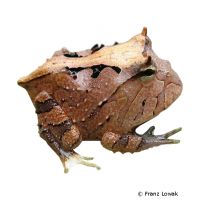Common Horned Frog (Ceratophrys aurita)
| Common Horned Frog Ceratophrys aurita | |
|---|---|
| Name | Common Horned Frog |
| Name Lat. | Ceratophrys aurita |
| Family | Ceratophryds |
| Family lat. | Ceratophryidae |
| Order | Frogs & Toads |
| Order lat. | Anura |
| Origin | Brazil |
| Habitat | Forest |
| Diet | Carnivore |
| Humidity | 60-70 % |
| Behavior | Predatory |
| Keeping | Individual |
| Care Level | Moderate |
| Breeding | Difficult |
| Housing | Semi-humid terrarium |
| Life Span | 8-10 years |
| Protection | No |
| Metric Units | |
| Size | 20-25 cm |
| Temperature | 24-28 °C |
| Housing Size | 60 x 60 x 50 cm |
| US Units | |
| Size | 7.9"-9.8" |
| Temperature | 75-82 °F |
| Housing Size | 25" x 25" x 20" |
Distribution and habitat
The range of the diurnal to crepuscular Great Brazilian Horned Frogs is in southeastern Brazil, along the Atlantic coast from Bahia to Rio Grande do Sul. They live in the forests, where they usually lurk for prey well camouflaged except for the top of their head and eyes buried in the ground. Their coloration and markings are very variable
Maintenance
For 1 animal, the minimum terrarium area is 3,600 cm² with a minimum effective height (measured without substrate) of 40 cm. This corresponds to a floor space of e.g. 60 x 60 cm. Keeping several animals in one terrarium outside the mating season should be avoided, as the animals are cannibalistic.
They need a loose, diggable substrate (e.g. coco humus) of at least 20 cm height. Potted plants that can be easily removed for cleaning are advantageous. A bathing opportunity must be offered, but the water level should not go above the animal's nostrils, as they are poor swimmers and could drown. At least once a day the inside of the terrarium must be finely sprayed with water (humidity), but a rain or mist system is better.
| Temp. day: 24-28 °C | Temp. night: 20-22 °C | Humidity: 60-70 |
The lighting duration must be 10-12 hrs. depending on the season. Daylight fluorescent tubes with low UV content are ideal. A dry rest of about 2 months at about 15 °C is recommended.
Diet
The food supply consists of cockroaches, grasshoppers, crickets, flour beetle and wax moth larvae, slugs, earthworms and young mice, but also small lizards and young snakes, according to their size. They will try to eat anything that moves and fits in their mouths. Feeders that are too small are often spurned. Adult animals should be fed every 7-10 days, younger animals more frequently. It is important to add minerals and vitamins regularly (e.g. by dusting the feeders). The quality of the feeder insects can be enhanced by the addition of overripe fruit and honey water
A varied diet promotes health and prevents deficiency symptoms.
Reproduction and breeding
The females are usually larger and more plump than the males, which can be recognized by their call during the mating season.
Summer dormancy is a prerequisite for successful breeding. In the following rainy season the female, which is ready to spawn, is taken in the mating grip (amplexus) by the male and she lays more than 1000 eggs in spawning balls in pools. The larvae hatch after about 3 days and are cannibalistic like the parents. After 3-5 weeks the transformation (metamorphosis) is completed and the young frogs leave the water.
Important
For summer dormancy (dry dormancy), the temperature must be lowered to about 15 °C and the humidity reduced. They form a cocoon and burrow into the ground. During this time they must not be disturbed or fed. After 6-8 weeks, the temperature is raised again, humidity is increased to 80-95% (rainy season) and the frogs finish their summer dormancy
The terrarium must have good ventilation without drafts and meet the species specific needs. Measuring devices, such as thermometers, hygrometers, etc. are necessary. The lighting has to correspond to the species-specific day-night rhythm and has to be placed in such a way that the animals cannot injure themselves. The terrarium should be locked in such a way that neither unauthorized persons can open it nor the animals can escape. Special attention must be paid to thorough hygiene and impurities must be removed regularly.
Further literature can be found in your pet store.
References
Text: petdata; Image: Franz Lowak
Source: VDA & DGHT (2006): Haltungsrichtlinien für die Haltung von Anuren; ENGELMANN (2006): Zootierhaltung - Tiere in menschlicher Obhut: Reptilien und Amphibien, Harri Deutsch Verlag
- Gemäß § 21 Abs. 5 Tierschutzgesetz idgF
